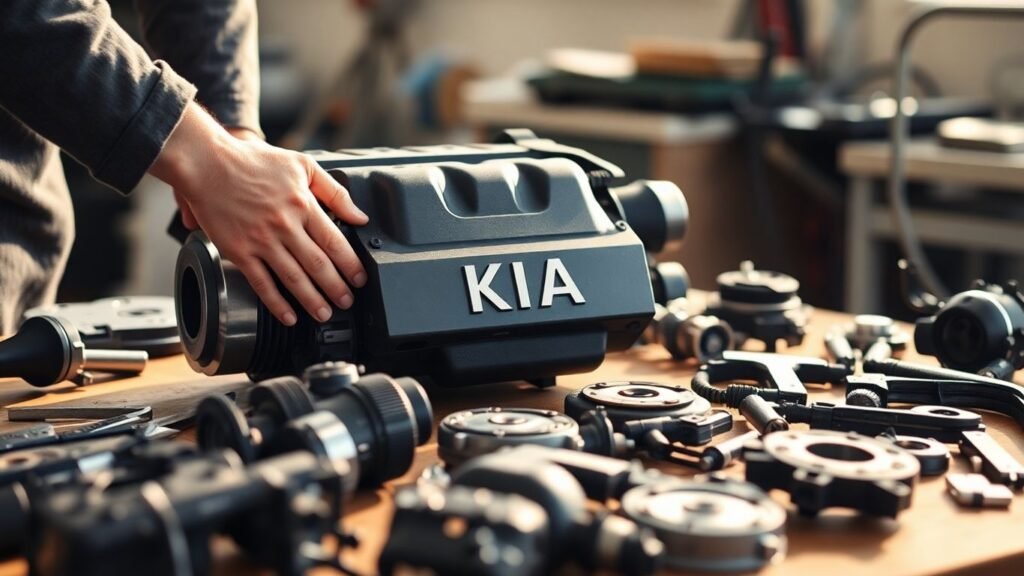Kia is really stepping up its game when it comes to being green. They’re not just talking about it; they’re actually doing things, from how they build cars to the materials they use. Plus, they’re pushing hard on electric vehicles. All of this is great for the planet, and it makes you think about how even the parts we don’t think about, like those from old cars, can play a role. Let’s look at how Kia wreckers fit into this picture of driving more sustainably.
Key Takeaways
- Kia is committed to making cars in a more eco-friendly way, using renewable energy and aiming for carbon neutrality.
- They’re expanding their electric vehicle options and making them more energy efficient.
- Kia is experimenting with unique sustainable materials for car interiors, like fungus and recycled ocean trash.
- The company is involved in projects to protect nature and reduce greenhouse gas emissions.
- Kia wreckers help keep cars on the road longer by providing parts, which cuts down on waste and offers cheaper options for drivers wanting to be more sustainable.
Kia’s Commitment to Eco-Friendly Manufacturing
Kia is really stepping up its game when it comes to making cars in a way that’s better for the planet. It’s not just about building cars anymore; it’s about how they’re built. They’re looking at everything from where their energy comes from to what goes into the car’s interior. It’s a pretty big shift, and honestly, it’s good to see a major car company taking this seriously.
Kia is actively bringing renewable energy into its factories. Think solar panels on the roofs and other clean energy sources powering the assembly lines. This means less reliance on fossil fuels, which directly cuts down on the pollution created during manufacturing. For example, some of their plants are already using solar power, which is a solid step towards cleaner production. It’s a smart move that helps reduce their overall carbon footprint.
Kia has set a pretty ambitious target: to become carbon neutral by 2045. This isn’t just about their own operations; they’re looking at their entire supply chain. That means working with suppliers to reduce emissions too. They’re also focusing on better waste management and using materials that have less impact. It’s a long-term plan, but it shows a real commitment to making a difference.
This kind of forward-thinking approach is what we need more of in big industries. It’s about making changes that have a lasting positive effect, not just quick fixes.
This is where things get really interesting. Kia is exploring and using materials that are much kinder to the environment. We’re talking about things like recycled plastics, plant-based materials, and even fabrics made from recycled bottles. They’re also looking into innovative options like using fungus-based materials for interior parts and repurposing ocean plastic. It proves that you don’t have to sacrifice quality or style to be sustainable. They’re even moving away from traditional animal leather and PVC in favor of more eco-friendly alternatives like bio-polyurethane, which comes from things like corn and eucalyptus.
| Material Type | Examples |
|---|---|
| Recycled | PET fabrics, metals |
| Plant-Based | Bioplastics, bio-polyurethane (corn, eucalyptus) |
| Innovative | Fungus-based materials, ocean plastic |
Driving the Electric Vehicle Revolution

Kia is really pushing hard into the electric vehicle space, and honestly, it’s about time. They’re not just dipping their toes in; they’re going all out with a whole lineup of EVs designed to make driving cleaner and more efficient. It feels like a big step towards a future where we don’t have to worry so much about gas prices or, you know, the planet.
Expanding the Electric Vehicle Lineup
Kia’s got a pretty impressive range of electric cars now, and they keep adding more. Models like the EV6 and the newer EV9 are leading the charge. They’re not just electric; they’re built with sustainability in mind from the ground up. You can see it in the materials they use, like recycled plastics and even things derived from ocean trash. It’s cool to think your car could be partly made from stuff that would have otherwise ended up polluting the ocean.
Enhanced Energy Efficiency in EV Production
It’s not just about the cars themselves being efficient; Kia is also looking at how they’re made. They’re working on making their factories use less energy, which is a big deal. Think smart systems and renewable power sources. This means the cars have a smaller environmental footprint even before they hit the road. Plus, it can help keep costs down, making EVs more accessible.
Promoting Cleaner Transportation Alternatives
Kia is making it easier for people to switch to electric. They’re partnering with charging networks, so you don’t have to stress about finding a place to plug in. They’re also offering these vehicles with good range and decent charging times. The goal is to make electric cars a practical and attractive choice for everyday drivers.
It’s becoming clear that the future of driving is electric, and Kia is putting a lot of effort into making that future a reality for more people. They’re thinking about the whole picture, from how the car is built to how you’ll use it day-to-day.
| Model | Estimated Range (Miles) | MPGe (City/Highway/Combined) |
|---|---|---|
| EV6 (RWD) | ~310 | 136/100/117 |
| EV9 (RWD) | 230 | 99/77/88 |
Innovative Interior Design for Sustainability
Kia is really thinking outside the box when it comes to what goes inside their cars. It’s not just about looking good anymore; it’s about being good for the planet too. They’re using some pretty wild materials that you wouldn’t expect to find in a vehicle, and honestly, it’s kind of cool.
Utilizing Fungus and Ocean Trash
So, get this: Kia is actually using fungus, specifically mycelium which is the root part of mushrooms, to create interior components. It’s surprisingly strong and can be molded into different shapes, making it a great alternative to plastics. Plus, they’re taking plastic waste that’s polluting our oceans and turning it into parts for their cars. This shows a real commitment to cleaning up our environment by finding new uses for what we’d otherwise throw away. It’s a smart way to tackle two big problems at once – reducing plastic waste and finding sustainable materials.
Kia’s approach to interior design is a clear signal that the automotive industry can move beyond traditional, resource-intensive materials. By embracing nature-based solutions and recycled waste, they’re proving that sustainability doesn’t mean sacrificing quality or aesthetics.
Recycled Fabrics and Vegan Leather Options
Beyond the more unusual materials, Kia is also making sure the everyday stuff is eco-friendly. You’ll find interiors made with fabrics that come from recycled plastic bottles. And if you’re not keen on animal products, they’ve got vegan leather options that look and feel great. It means you can have a comfortable and stylish car interior without the environmental baggage.
The Symbiotic Relationship Between Technology and Nature
What’s really neat is how Kia is trying to blend technology with nature. It’s like they’re saying we don’t have to choose between having advanced cars and protecting the environment. By using materials that are grown or recycled, they’re creating a connection between the car and the natural world it drives through. This philosophy is becoming a big part of their electric vehicle designs, showing that the future of driving can be both high-tech and harmonious with nature.
Kia’s Role in Reducing Environmental Impact

Kia is really stepping up when it comes to being good to the planet. It’s not just about making cars; it’s about how they’re made and what happens to them. They’re looking at the whole picture, from the factory floor to the materials used, and even what happens after a car has had a long life.
Biodiversity Conservation Initiatives
It turns out, Kia understands that cars don’t exist in a vacuum. They know that their operations can affect natural habitats, so they’re actively working to protect them. This includes things like restoring coastal areas and even partnering with groups that clean up the oceans. They’re also trying to make their own workplaces greener by adding more green spaces. It’s a pretty thoughtful approach, recognizing that a healthy environment is important for everyone.
Kia is taking steps to protect natural habitats by assessing risks and starting conservation projects. They’re working on restoring coastal areas and cleaning up ocean waste, showing a commitment to preserving the natural world around their operations.
Environmental Management Data and Reporting
To keep track of all these efforts, Kia is big on data. They’re assessing where their business might impact biodiversity, using tools to understand these risks. This kind of detailed tracking helps them make better decisions and report on their progress. It’s like keeping a detailed logbook for their environmental performance, which is pretty important for accountability.
| Assessment Area | Year Conducted | Tool Used |
|---|---|---|
| Biodiversity Risk | 2023 | WWF’s Biodiversity Risk Filter (BRF) |
| Global Business Sites | 2023 | WWF’s Biodiversity Risk Filter (BRF) |
Reducing Greenhouse Gas Emissions
This is a big one, obviously. Kia is working hard to cut down on greenhouse gases. A lot of this comes down to how they make their cars, using cleaner energy in their factories and trying to be more efficient. They’ve set a goal to be carbon neutral by 2045, which is a pretty ambitious target. This involves looking at their entire supply chain, not just their own factories. It’s a long-term plan that shows they’re serious about making a difference in the fight against climate change.
How Kia Wreckers Support Sustainable Driving
Extending Vehicle Lifespans Through Parts
When a Kia vehicle reaches the end of its road, it doesn’t necessarily mean its parts have to be tossed aside. Kia wreckers, often called auto recyclers, play a pretty big role in keeping usable components out of landfills. Think about it: a perfectly good alternator, a set of tires with plenty of tread left, or even a transmission that’s still in great shape can be salvaged. These parts are then cleaned up, tested, and made available for other Kia owners who might need them for repairs. This practice directly extends the life of vehicles on the road, reducing the demand for brand-new manufactured parts, which in turn saves energy and resources. It’s a smart way to keep Kias running longer and reduce the overall environmental footprint of car ownership.
Reducing Waste in the Automotive Lifecycle
The automotive industry, as you know, creates a lot of waste. From the initial manufacturing process to eventual disposal, there are many points where materials can end up as trash. Kia wreckers help break this cycle. Instead of crushing an entire car and sending it all to be melted down or buried, they meticulously dismantle it. Fluids are drained and disposed of properly, metals are sorted for recycling, and those valuable reusable parts we just talked about are saved. This careful deconstruction means less raw material needs to be extracted for new parts and less material ends up in landfills. It’s a more thoughtful approach to what happens to a car when it’s no longer drivable.
The process of salvaging and reusing Kia parts is a quiet but significant contributor to a circular economy within the automotive sector. It’s about seeing value where others might see scrap.
Providing Affordable Sustainable Vehicle Options
Let’s be honest, buying a new car, especially an electric one, can be a huge expense. For many people, a brand-new Kia might be out of reach. This is where Kia wreckers step in to offer a more budget-friendly path to sustainable driving. By providing access to reliable, pre-owned Kia parts, they make it more affordable for owners to maintain their existing vehicles, potentially keeping them on the road longer and avoiding the purchase of a new car altogether. Furthermore, some wreckers might even offer salvaged or refurbished Kia models that are still in good working order, giving individuals a chance to own a Kia without the hefty price tag of a new one. This accessibility is key to making greener transportation choices available to a wider range of people. | Type of Part | Typical Lifespan Extension | Environmental Benefit |
|—|—|—|
| Engine Components | 50,000 – 100,000 miles | Reduced manufacturing energy |
| Body Panels | Years of use | Less scrap metal |
| Interior Parts | Years of use | Reduced plastic waste |
Driving Towards a Greener Tomorrow
So, it’s pretty clear that Kia isn’t just building cars; they’re really trying to build a better future. From using recycled stuff in their car interiors to powering their factories with clean energy, they’re making a noticeable effort. It’s not just about making electric cars, though that’s a big part of it. It’s about thinking about the whole process, from start to finish, and trying to leave a lighter footprint on the planet. For anyone looking to drive a bit more responsibly, Kia seems to be making it easier and easier to do just that. They’re showing that you don’t have to sacrifice style or performance to be kinder to the environment.








